I have been able to give my family a much nicer home and a much better start in life than I had foreseen before the great climb. This is what gives the greatest satisfaction; my family is my first concern and my greatest pleasure.
-said Tenzing Norgay after climbing Mt. Everest.
The above quote is carved on a stone beside Tenzing’s grave (samadhi) at the Himalayan Mountaineering Institute (HMI). His historic climb to Mt. Everest inspired the government of that time to establish this institute to guide and train mountaineers.
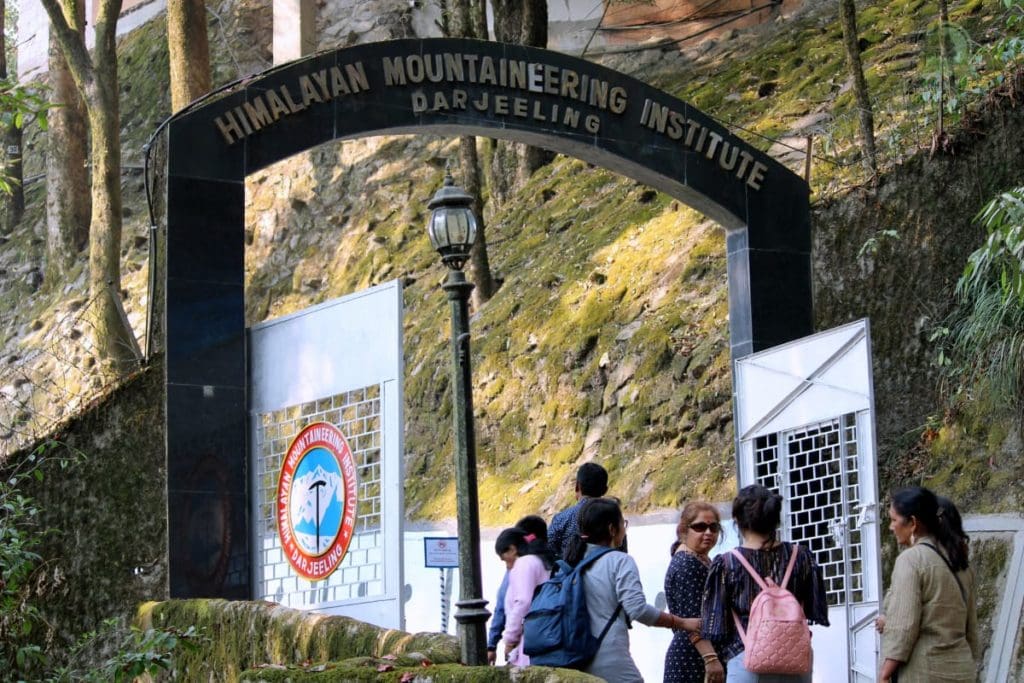
History Of Himalayan Mountaineering Institute (HMI)
On 29th May 1953, Tenzing Norgay sherpa became the first man to climb Mount Everest along with Edmund Hillary. It was the victory of human endeavour and continued perseverance. The Himalayan Mountaineering Institute was built to give tribute to Tenzing Norgay for training climbing enthusiasts. Sherpa Tenzing Norgay was awarded to prestigious Padma Bhusan, President’s Gold Medal, and IMF Gold Medal.
On 4th November 1954, Pandit Jawahar Lal Nehru, the first prime minister of India, laid the foundation stone of the Himalayan Mountaineering Institute designed by the architect Joseph Allen Stein. Tenzing was director of Field Training and Adviser at HMI from its inception till his death on 9th May 1986. Narendra Dhar Jayal was the founding principal of the institute.
All interested mountaineer, including international students within allowable age limits, can enrol their names in the institute’s mountaineering and rock climbing course. More than 45000 students, including 2500 from abroad, have been trained here till now.
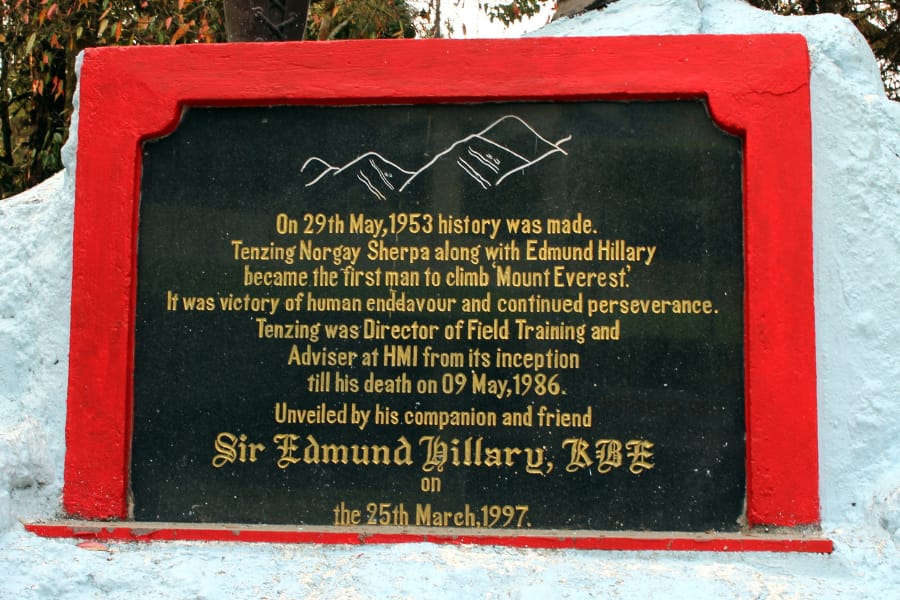
How To Reach Himalayan Mountaineering Institute?
The Himalayan Mountaineering Institute is situated at an elevation of 7000 ft. To reach the Himalayan Mountaineering Institute, you must arrive at Darjeeling. Darjeeling is very well connected via train route (New Jalpaiguri Railway Station), air (Bagdogra Airport) and road from all parts of India.
Himalayan Mountaineering Institute is located inside the Padmaja Naidu Himalayan Zoological Park at Jawahar Parbat in Darjeeling. From Chowrasta (Mall), take Jawahar Road, and by 30 minutes walk, you will reach the zoo’s gate.
Alternatively, you can hire a car from Chowk Bazaar which will take 15 minutes to arrive. Cars are parked along Lebong Cart Road from where walk uphill for 5-10 minutes to the entrance.
As you enter the zoo’s main gate, you will see small souvenirs on the left and the Guide Map of the zoo on the right. Going a little further, you will reach the centre point of the zoo, where a beautiful garden full of ornamental flowers will surely attract you.
Just in front of the garden, there is the enclosure of a Himalayan black bear. Walk past the section and go a little further up, and you will see the gate of the Himalayan Mountaineering Institute (HMI).
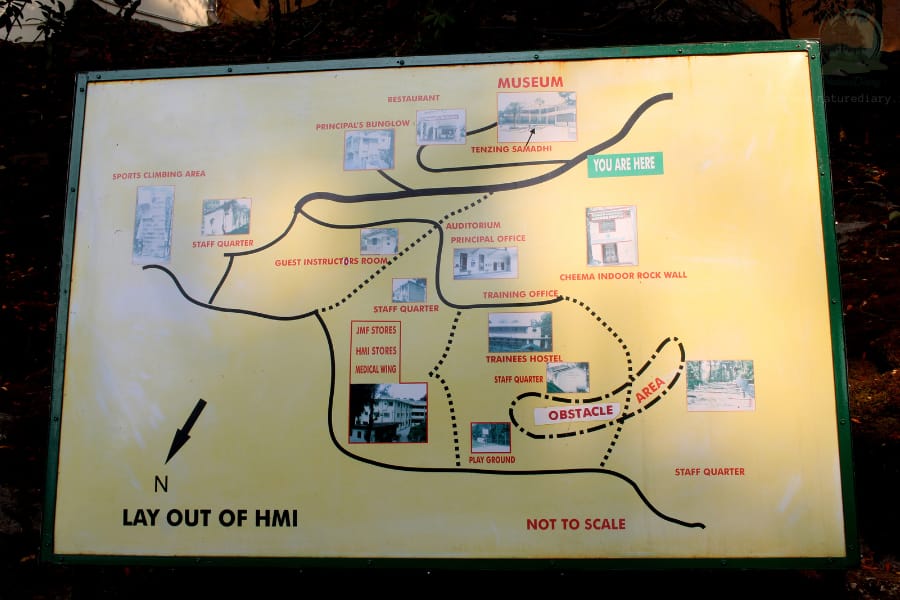
HMI Timing And Entry Fees
The entire Padmaja Naidu zoological park, including the zoo, Himalayan Mountaineering Institute, and Bengal Natural history museum open daily from 8.30 am to 4 pm. It remains closed on Thursdays. During the festivals, the visiting hours might differ.
The combined entry fee for the entire park is ₹60 for Indian and SAARC country nationals. ₹100 for other foreign countries. A child below 6 years is free. You have to pay an extra charge of 10 rupees for carrying cameras. However, please note that photography is prohibited inside the Himalayan Mountaineering Institute.
The Himalayan Mountaineering Institute Campus
The entire campus of HMI consists of a tree-top rope course, museum, library, auditorium, souvenir shop, gymnasium, hostel for trainees, medical wing, equipment wing, and indoor and outdoor training aids.
At the entrance of HMI, the tree-top rope climbing facility is open for tourists. They can perform different adventurous activities like Zip lining, Treetop rope course, wall climbing, etc. It consists of 11 obstacles, including Zip Line, placed 15-30 feet above the ground and is operated by qualified instructors.
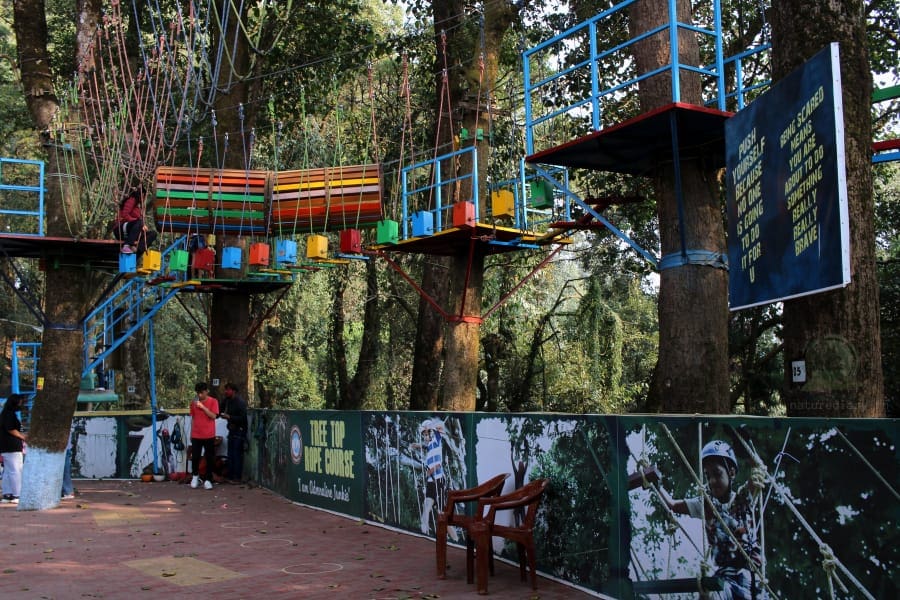
The HMI library has over 2800 valuable books on mountaineering, travel, exploration, astronomy, flora, and fauna of the Himalayan region. The Jayal Auditorium, named after the Late Major Nandu Jayal, the first Principal of the Institute, is used for lectures, conferences, and the screening of mountaineering films to up to 225 students and visitors at a time.
Courses At The Mountaineering School, HMI
Himalayan mountaineering institute conducts various mountaineering courses that help develop skills for the trainees in mountain climbing. It offers three types of courses-
| Courses | Duration | Eligible Age | No. Of Seats | Courses/Year |
|---|---|---|---|---|
| Basic | 28 days | 17-45 years | 60 | 7 |
| Advance | 28 days | 17-45 years | 40 | 3 |
| Search And Rescue | 23 days | 17-45 years | 30 | 1 |
| Method Of Instruction | 23 days | 17-45 years | 20 | 1 |
| Adventure | 15 days | Above 12 years | 70* | 4 |
| Sports & Rock Climbing | 5 days | Above 12 years | 20 | 3 |
| Expedition to Mt. Frey | 16 days | 17-45 years | 20 | 2 |
* There is also a special adventure course for visually handicapped persons/underprivileged children above 12 years with 30 seats. Apart from the above courses, the Winter Alpine Climbing Training and Winter Trek to HMI Base Camp- two special courses are conducted once a year. You can even customize the training program according to your requirements. HMI also arranges trekking to Sandakphu in the Singalila range.
The basic course empowers the individual in rock, snow, ice climbing, and any expedition up to a height of 7000 meters. On the other hand, the adventure course encourages an individual in trekking, camping, rock crafting, and water sports with discipline. Lastly, the advanced course provides advanced training for climbing a mountain under the supervision of instructors.
The price of each course differs every year according to the budget. You can check HMI’s official website for details of the course fees.
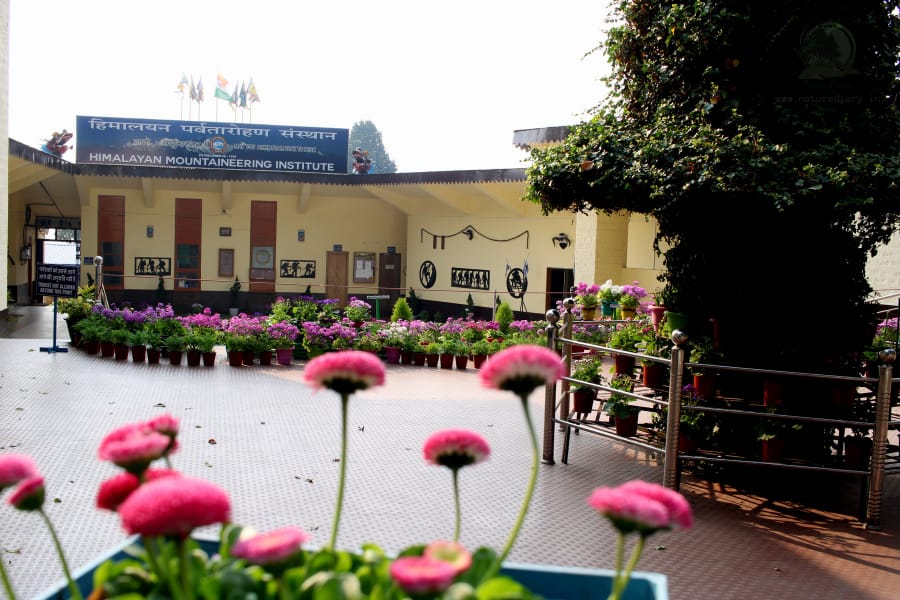
The HMI Museum
Established in 1957, the objective of the HMI museum is to facilitate educational activities on mountaineering and the mountain environment to preserve historical monuments. The museum has a rich collection of artefacts, models, paintings, sculptures, photographs, manuscripts, autographs, books, and mountaineering equipment belonging to famous mountaineers.
The two-storied museum has three sections – Mountaineering History, Mount Everest Expedition, and a gallery with A Panorama Of Himalayan Life. After entering the gate of the museum, you will see a help counter on the right where you can clarify your queries. From this point, photography is prohibited, so we could not use our cameras.
Mountaineering History Section
As you walk through the main hall, you will see the historical photos of Tenzing Norgay, Jawahar Lal Nehru, the former prime minister, Bidhan Chandra Roy, the former chief minister and Haren Mukherjee, the former governor of West Bengal.
Walking further down the ground floor, you will see a craft of the entire Himalayan mountain range, with its peaks, glaciers, canyons, crevices and river systems. This is a fantastic visual representation of the Himalayas for trekking, hiking and mountaineering enthusiasts.
Mountaineering essentials like oxygen cylinders, snow shovels, wireless sets, trekking shoes, gloves, jackets, hats, headlamps, pit furnaces, camping tents and compasses used in the historical climbing events are exhibited in the “Equipment in Voyage” section.
Walking forward, you can also see the flags, medals and badges of honour of various mountaineering clubs and associations like the Swiss Alpine Club, German Mountaineering Club, and Iranian Expedition. Then you will come to the photo gallery of mountaineers who successfully climbed Mt. Everest.
A Panorama of Himalayan Life
This section is dedicated to the artefacts and models related to the art, culture, flora, and fauna of the Himalayas. Various ancient artefacts, apparel, hats, utensils, tool and equipment in the lifestyle of the Himalayan people are also displayed by HMI. Birds and animals of the Himalayan region are showcased. You will see flying squirrels, snow foxes, Himalayan crows, Red-legged Partridge, etc. You can also see samples of rocks and minerals of geological significance in this section.
The Mount Everest Section
HMI has dedicated the second floor to Mt. Everest. As you walk up the stairs and enter the hall, you will see the historical roadmap of conquering Everest. Radhanath Sikdar, the Indian mathematician, discovered peak XV as the highest point on the earth and named the peak Mt. Everest in honour of Surveyor General of India George Everest in 1852- the detailed event is well documented here.
The next remarkable thing you will notice here is the models of mountaineers crossing the crevice using ladders, climbing up the mountains and performing various activities. Walking further, you will see used mountaineering gear like jackets, rucksacks, gloves, scarves, sleeping bags and ice axe by famous mountaineers and detailed information about them.
The picture of Tenzing Norgay and Edmund Hillary shot on top of Everest on 29th May 1953 at 11.30 am, will surely amaze you. Not only Tenzing Norgay, but the museum will also introduce us to Indian mountaineers like Sherpa Nawang Gombu, Bachendri Pal, and many others.
Sherpa Nawang Gombu was the first person to reach the top of Mt. Everest twice in 1963 and 1965. He also conquered Sasser Kangri, Nanda Devi, Cho-Oyu, and many other mountain peaks. Bachendri Pal was the first Indian woman to climb mt. Everest in 1984. The controversial event of the disappearance of George Mallory and Andrew Irvine in 1924 during the British Everest Expedition is also narrated here.
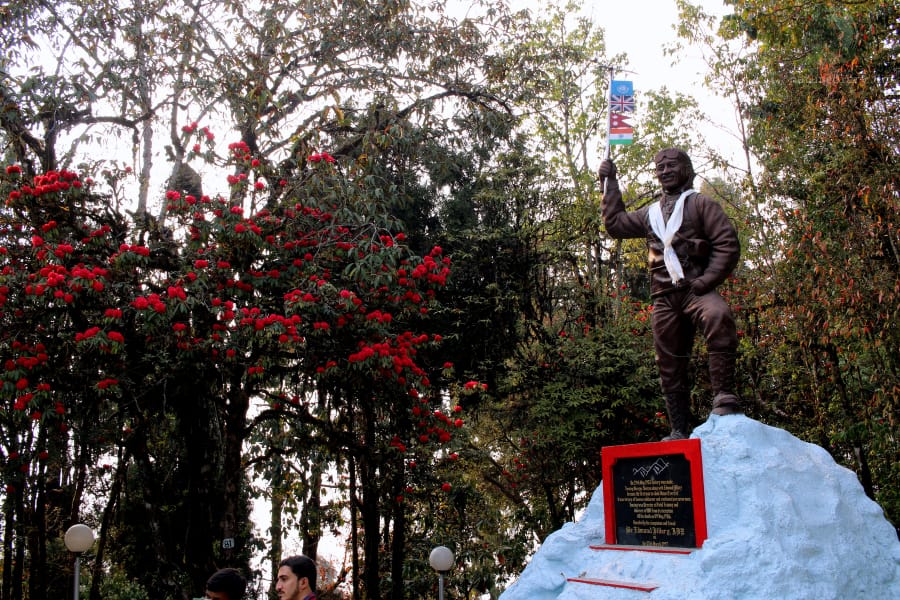
Walking further on the second floor, you can witness the famous Veb carl Zeiss telescope, a gift to General Shamsher Jung Bahadur Rana, commander-in-Chief of the Nepalese army by Adolf Hitler. Later, Major Rana gifted it to the institute on 7th July 1961. Now, this telescope carries the symbol of a friendly relationship between India and Nepal.
Other Attractions Of the Himalayan Mountaineering Institute
There is ample open space to spend time just outside of the museum. A few small souvenir shops, tea parlours, and restaurants are located on the premises. Visitors can take various kinds of mementoes, literature, prospectus, and souvenirs showcasing HMI activities at subsidized prices from the shops. It is an interesting place for collectors and mountaineering enthusiasts.
There is a statue of Sherpa Tenzing Norgay standing with four flags of India, Nepal, Britain, and the United Nations in his ice axe. Near the middle of the premises, there lies his grave. A note from Sir Edmund Hillary is engraved on the burial where Hillary said about Tenzing Norgay:
I have never regarded myself as much of a hero but Tenzing. I believe it undoubtedly was. From humble beginnings, he had achieved the summit of the world.
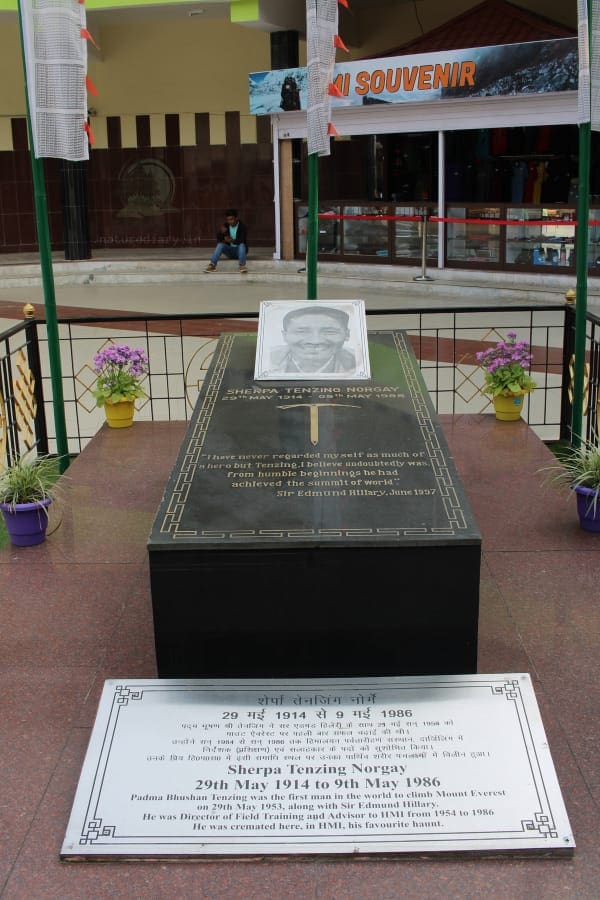
HMI At A Glance
| Place | Himalayan Mountaineering Institute |
| Address | Jawahar Parvat, Darjeeling: 734101, West Bengal, India |
| Latitude And Longitude | 27.0586° N, 88.2532° E |
| Contact No. | +9176022 15312 (Training Office) |
| Email Address | hmidarj@gmail.com |
| Founded On | 4 November 1954 |
| Founders | Tenzing Norgay, Jawaharlal Nehru |
| Principal | Gp. Capt. Jai Kishan |
| Motto | May (You) Climb From Peak To Peak |